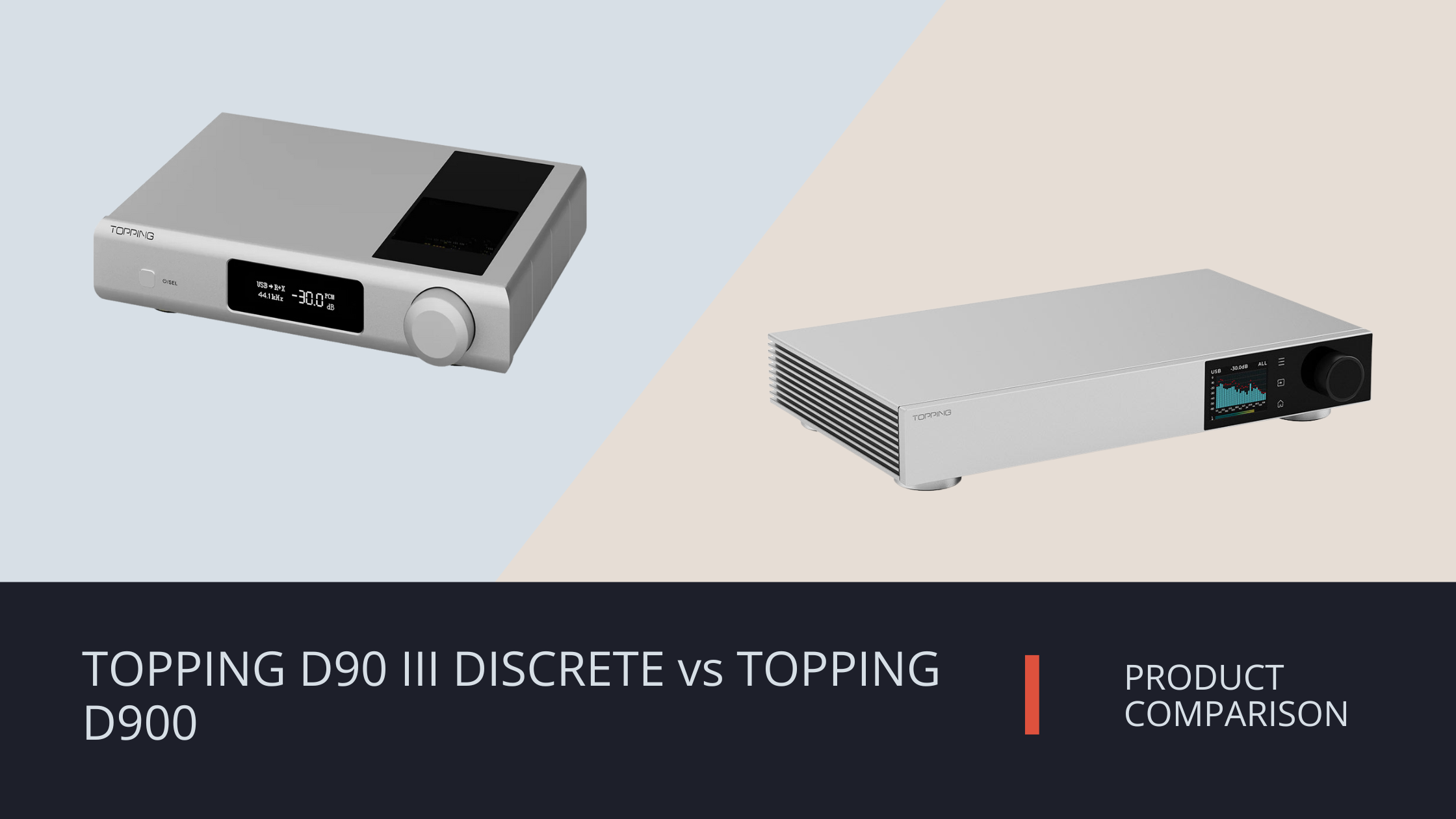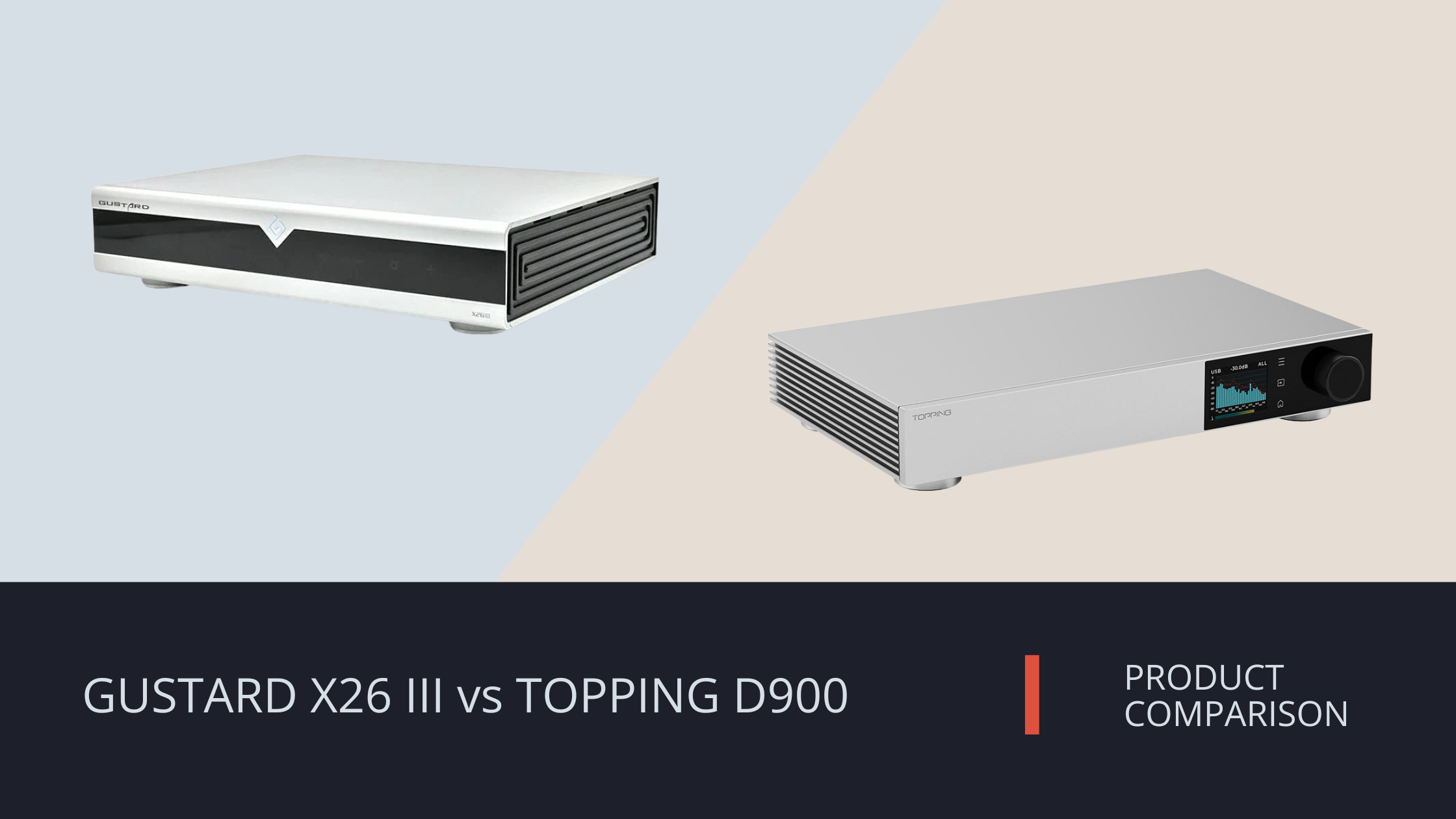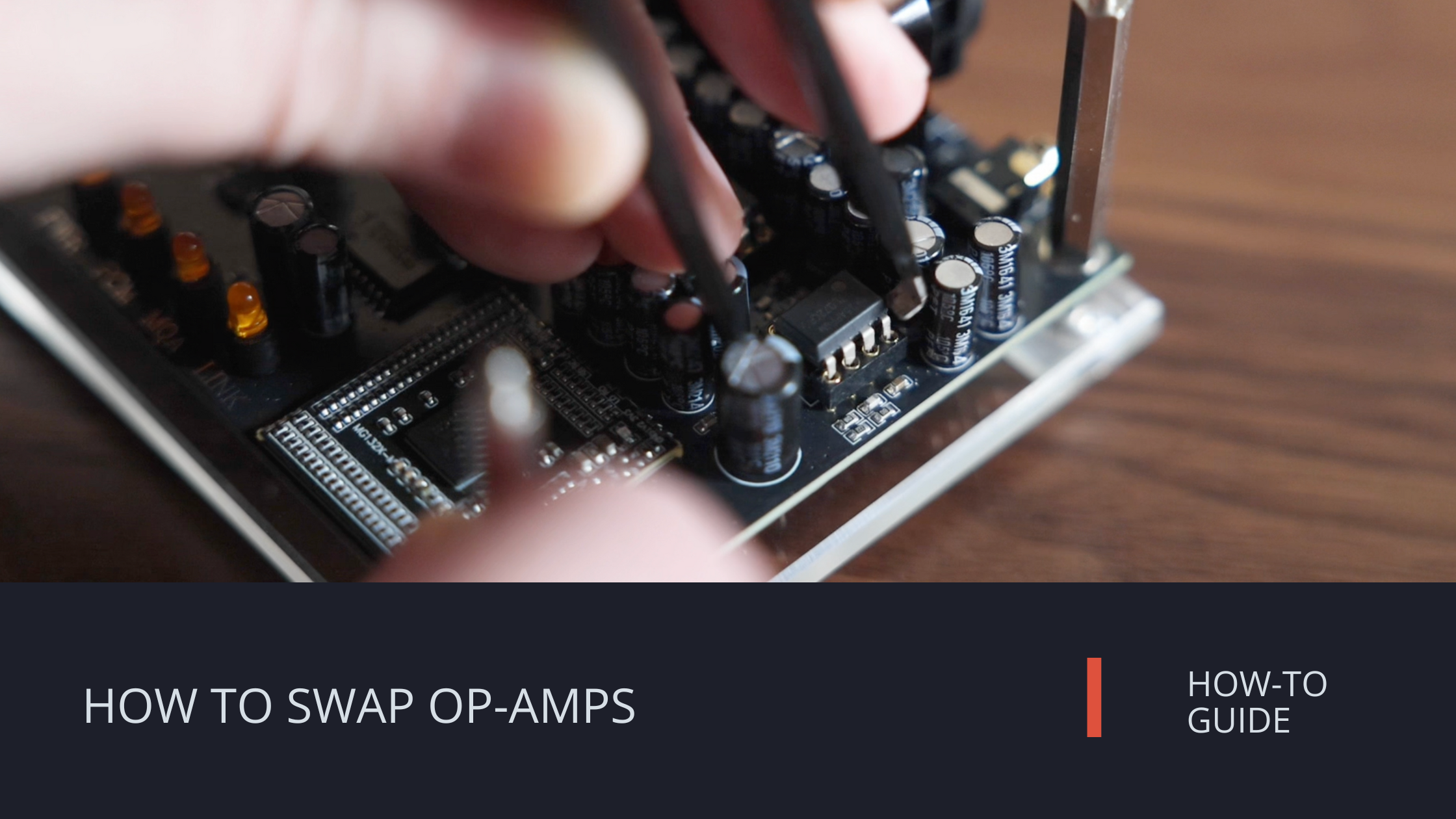
TOPPING D900 vs TOPPING D90 III Discrete
How two flagship TOPPING DACs differ in design, performance, and purpose
In this post, we’ll walk through how the TOPPING D900 and TOPPING D90 III Discrete differ in measurable performance, usability, and engineering design—and where each might fit best in a serious system. If you already know what discrete architectures and balanced pre-amp stages are, this comparison will help clarify the trade-offs between TOPPING’s two flagship approaches.
Overview
The D900 is the brand’s newest flagship DAC and pre-amp, built around TOPPING’s proprietary PSRM (Phase-Switching Reference Modulator) 1-bit discrete decoding system. With 32 conversion elements per channel, it delivers ultra-low distortion, exceptional linearity, and a wide ~131 dB signal-to-noise ratio. Bluetooth 5.1 with LDAC and aptX Adaptive adds flexibility, and its pre-amp mode with memory-retained volume control makes it equally at home in desktop or full-size systems.
The D90 III Discrete represents the earlier generation of TOPPING’s PSRM technology—using 16-phase discrete 1-bit modules per channel—and refines it into a reference‐grade DAC with both XLR and RCA outputs, full wired and Bluetooth connectivity, and a high-precision pre-amp mode. It offers performance within a hair of the D900’s, at a lower cost and in a more traditional form factor.
In rough terms:
- The D900 pushes TOPPING’s discrete architecture to its highest measured limits and adds convenience features.
-
The D90 III Discrete balances flagship-level transparency with broader compatibility and value.
Architecture & Conversion Approach
D900 — 32-element PSRM discrete 1-bit DAC
The D900 uses TOPPING’s latest 1-bit PSRM architecture, comprising 32 discrete switching elements per channel synchronized for ultra-linear conversion. Each channel’s output passes through a custom I/V stage and precision-regulated local supplies. This design eliminates traditional delta-sigma modulation noise while preserving high-frequency linearity and micro-detail. The result is THD+N < 0.000055 % and an SNR of ~131 dB.
D90 III Discrete — 16-phase PSRM module
The D90 III Discrete employs TOPPING’s 16-phase PSRM system per channel. Though earlier than the D900’s 32-element implementation, it maintains the same design philosophy: a self‐developed discrete DAC core free of conventional chip-level constraints. It outputs via high-precision I/V conversion and supports pre-amp volume control with memory.
Both architectures share the same goal — pure 1-bit reconstruction and vanishingly low nonlinearity — but the D900 extends that design with more elements and refined power regulation.
Features & Connectivity Comparison
| Feature | D900 | D90 III Discrete |
|---|---|---|
| DAC architecture | 32-element PSRM 1-bit discrete | 16-phase PSRM 1-bit discrete |
| Bluetooth | 5.1 (LDAC / aptX Adaptive) | 5.1 (LDAC / aptX Adaptive) |
| Preamp / Volume Mode | Digital/analog hybrid with memory | Digital/analog hybrid with memory |
| Outputs | Balanced XLR + Single-ended RCA | Balanced XLR + Single-ended RCA |
| Output voltage | ~4.0 Vrms (XLR) / ~2.0 Vrms (RCA) | ~4.2–5.2 Vrms (XLR) / ~2.1–2.6 Vrms (RCA) |
| Inputs | USB-B, USB-C, AES, I²S (LVDS), Coaxial, Optical | USB-B, USB-C, AES, I²S (LVDS), Coaxial, Optical |
| Supported formats | PCM up to 768 kHz / DSD512 | PCM up to 768 kHz / DSD512 (native) |
| Trigger ports | Yes | Yes |
| PEQ / Tone control | 10-band PEQ | 10-band PEQ |
| Network / Streaming | None (external streamer required) | None (external streamer required) |
Performance Comparisons & Trade-offs
Noise floor and dynamic range
The D900 measures THD+N < 0.000055 % and SNR ~131 dB. The D90 III Discrete comes in just behind, at THD+N < 0.00006 % and SNR ~131 dB. In real-world use, these figures are effectively indistinguishable — both sit far below audible thresholds — but the D900 maintains its distortion profile across a wider range of frequencies and loads due to the expanded PSRM matrix.
Output behavior and gain structure
The D900’s ~4 Vrms balanced output is suitable for most headphone amplifiers and integrated systems. The D90 III Discrete adds a switchable 4 V / 5 V mode, providing additional headroom for professional or high-impedance amplifiers. Output impedance is specified at 50 Ω (RCA) / 150 Ω (XLR) for the D90 III Discrete.
Control and user interface
Both units include colour OLED displays, solid aluminium remotes, and menu-based configuration. The D90 III Discrete adds EQ, filter, and display adjustments, while the D900 keeps a streamlined interface for pure DAC operation.
Flexibility vs Specialization
- D900: Best suited for listeners who want flagship-level transparency, wireless convenience, and pre-amp functionality in one chassis.
- D90 III Discrete: Ideal for purist, fully balanced chains that benefit from its PEQ, analog-style gain control, and reference-grade noise floor.
Where Each Makes Most Sense
- If you want RCA compatibility: Go with the D900—it’s more versatile overall, serving as both a discrete DAC and preamp with wireless and memory-retained volume.
- If your system is fully-balanced and you value value: The D90 III Discrete gives you flagship-level transparency and PEQ tuning at a significantly lower price.
- If you rely on EQ or want fine-grained tone control: The D90 III Discrete has a 10-band PEQ that the D900 also offers, but in a more menu-driven interface.
- If you want the absolute top of TOPPING’s discrete design: The D900 is technically superior—32-element PSRM vs 16-phase, higher-precision regulation, and better preamp behavior—making it the true reference for fully balanced systems and mixed-input setups alike.
Product Highlights
D900
- 32-element PSRM discrete 1-bit architecture
- THD+N < 0.000055 % / SNR ~131 dB
- ~4.0 Vrms (XLR) / ~2.0 Vrms (RCA) outputs
- Bluetooth 5.1 (LDAC / aptX Adaptive)
- PCM up to 768 kHz / DSD512
- 10-band PEQ
- Pre-amp mode with memory volume
- Trigger ports
- Price: $1,799 USD
D90 III Discrete
- 16-phase PSRM discrete 1-bit architecture
- THD+N < 0.00006 % / SNR ~131 dB
- Up to ~5.2 Vrms balanced output
- 10-band PEQ + pre-amp mode
- Bluetooth 5.1 (LDAC / aptX Adaptive)
- PCM up to 768 kHz / DSD512 (native)
- Trigger ports and remote control
- Price: $999 USD


